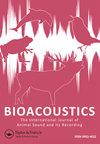Passive acoustic monitoring in terrestrial vertebrates: a review
IF 2.1
4区 生物学
Q2 ZOOLOGY
Bioacoustics-The International Journal of Animal Sound and Its Recording
Pub Date : 2023-05-10
DOI:10.1080/09524622.2023.2209052
引用次数: 2
Abstract
ABSTRACT Passive acoustic monitoring (PAM) has become increasingly popular in ecological studies, but its efficacy for assessing overall terrestrial vertebrate biodiversity is unclear. To quantify this, its performance for species detection must be directly compared to that obtained using traditional observer-based monitoring (OBM). Here, we review such comparisons across all major terrestrial vertebrate classes and identify factors impacting PAM performance. From 41 studies, we found that while PAM-OBM comparisons have been made for all major terrestrial vertebrate classes, most comparisons have focused on birds (65%) in North America (52%). PAM performed equally well or better (61%) compared to OBM in general. We found no statistical difference between the methods for total number of species detected across all vertebrate classes (excluding reptiles); however, recording period and region of study influenced the relative performance of PAM, while acoustic analysis method and which method sampled for longer overall showed no impact. Further studies comparing PAM performance in non-avian vertebrates using standardised methods are needed to investigate in more detail the factors that may influence PAM performance. While PAM is a valuable tool for vertebrate surveys, a combined approach with targeted OBM for non-vocal species should achieve the most comprehensive assessment of terrestrial vertebrate communities.陆生脊椎动物被动声学监测研究进展
被动声监测(PAM)在生态学研究中越来越受欢迎,但其在评估陆生脊椎动物整体生物多样性方面的有效性尚不清楚。为了量化这一点,必须直接将其在物种检测方面的性能与传统的基于观测者的监测(OBM)所获得的性能进行比较。在这里,我们回顾了所有主要陆生脊椎动物类别的这种比较,并确定了影响PAM性能的因素。从41项研究中,我们发现,虽然PAM-OBM比较了所有主要的陆生脊椎动物类别,但大多数比较集中在北美(52%)的鸟类(65%)。与一般的OBM相比,PAM的表现同样好或更好(61%)。我们发现在所有脊椎动物类别(不包括爬行动物)中检测到的物种总数的方法之间没有统计学差异;然而,记录时间和研究区域对PAM的相对性能有影响,而声学分析方法和哪种方法采样时间更长总体上没有影响。需要使用标准化方法对非鸟类脊椎动物的PAM性能进行进一步的比较研究,以更详细地调查可能影响PAM性能的因素。虽然PAM是一种有价值的脊椎动物调查工具,但结合针对非发声物种的OBM方法应该能实现对陆地脊椎动物群落的最全面评估。
本文章由计算机程序翻译,如有差异,请以英文原文为准。
求助全文
约1分钟内获得全文
求助全文
来源期刊
CiteScore
4.50
自引率
0.00%
发文量
25
审稿时长
>12 weeks
期刊介绍:
Bioacoustics primarily publishes high-quality original research papers and reviews on sound communication in birds, mammals, amphibians, reptiles, fish, insects and other invertebrates, including the following topics :
-Communication and related behaviour-
Sound production-
Hearing-
Ontogeny and learning-
Bioacoustics in taxonomy and systematics-
Impacts of noise-
Bioacoustics in environmental monitoring-
Identification techniques and applications-
Recording and analysis-
Equipment and techniques-
Ultrasound and infrasound-
Underwater sound-
Bioacoustical sound structures, patterns, variation and repertoires

 求助内容:
求助内容: 应助结果提醒方式:
应助结果提醒方式:


